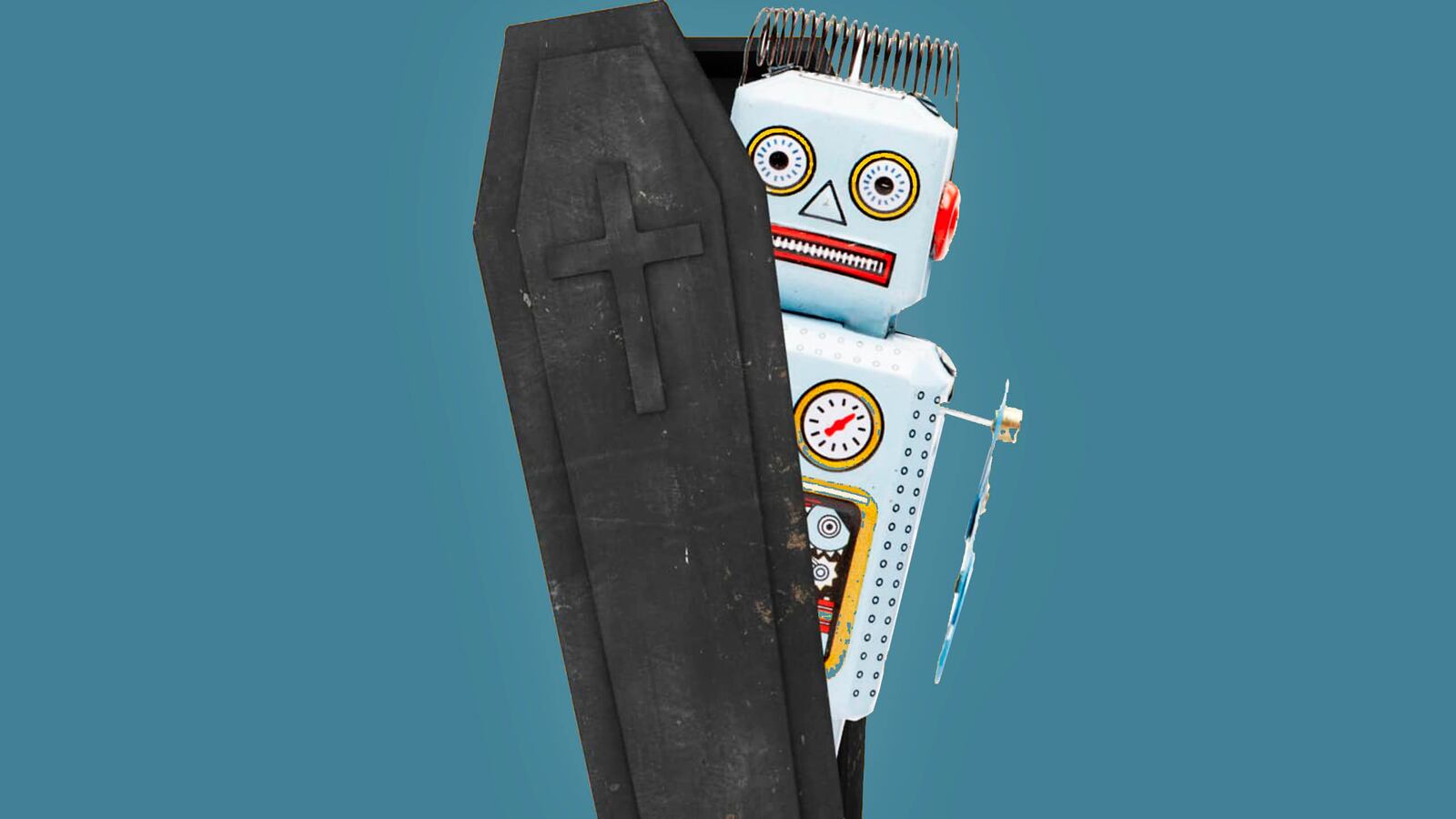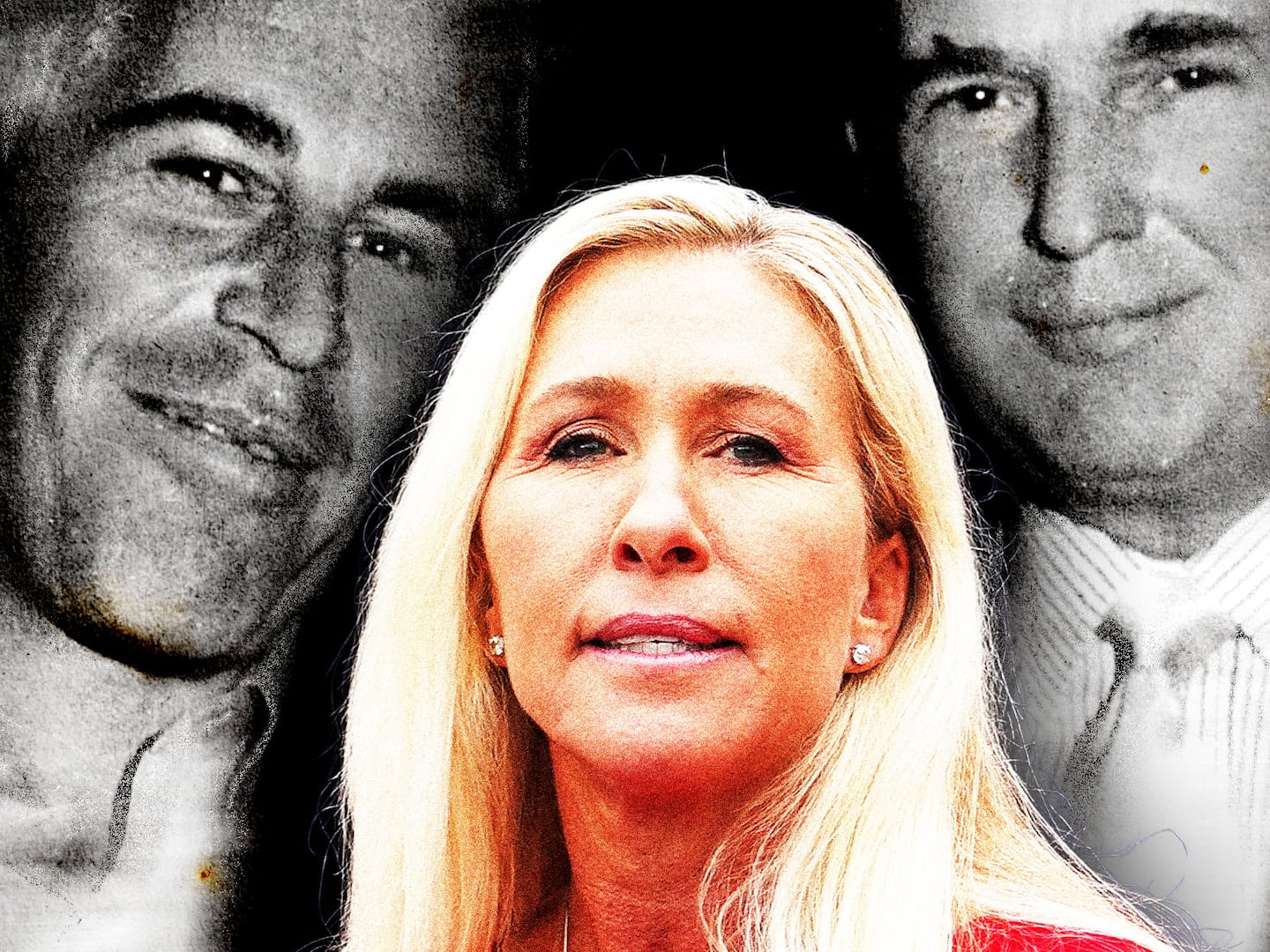Losing a loved one can be a traumatic experience, so it's unsurprising that mourners often hunt for a sign or piece of them.
And now, thanks to advanced technology, it’s possible.
Services such as Eterni.me advertise virtual immortality by gathering Facebook posts, Tweets, Instagram pictures, and emails into an accessible multimedia memorial. According to its website, Eterni.me will also create a digital avatar in the likeness of the deceased so “people in the future could actually interact with your memories, stories and ideas, almost as if they were talking to you.”
The thinking goes like this: Memories die with those who keep them, but data lasts forever. If a replica of a person is convincing enough, these services could “extend someone’s social life,” Clarissa Carden, a PhD candidate currently co-authoring a book, Living and Dying in a Virtual World, told The Daily Beast. However, Carden suspects that “it will be a long time—if ever—before digital replications obtain the same kind of social significance as ‘true’ remainders.”
But is that really how people want to be remembered? After all, you can be careful with social media posts; whether you want those digital communiques to represent you posthumously is another question.
In 2015, programmer Eugenia Kuyda’s best friend, 33-year-old Roman Mazurenko, died after getting hit by a car. After struggling to memorialize her friend meaningfully, Kuyda created a “Roman bot” programmed with years’ worth of text messages and social media posts. She found comfort in the bot and messages it frequently—the exchanges get increasingly realistic the more they communicate—and she has made it available to other friends and family (you can see conversation logs here). But Kuyda's exchange raises a huge concern: Do the dead have a say in whether or not a bot can me created in their likeness?
It’s hard to imagine corresponding with such a bot. When my dad died, I emailed him for months. If I’d received an email back I’d have been deeply disconcerted. I doubt that a facsimile would have comforted me, but perhaps during the loneliest and hardest times, it would have been better than nothing.
Or maybe not.
According to Carden, while these services “cannot change the fundamental fact that at the moment of death, our experience stops,” they may affect the way we grieve. Because we all have or will experience loss, we also experience “a desire to return to a relationship or a connection which is irrevocably gone,” Carden said. In the research Carden has conducted in the virtual world Second Life, she’s found that people engage in similar grieving behavior as they do off-line, creating “elaborate memorials in which they can sit with photographs of a person who has died and speak to them.” Eterni.me and similar services provide another way to maintain a connection that transcends death—one that despite its virtual nature may feel substantive because it takes the form of real-time communication.
The law is slowly catching up with the future of our digital, eternal selves. In a “digital will,” a person can specify what happens with their social media accounts in the event of death. Dead Social allows users to name a “legacy contact” to control those accounts; the service also allows people to compose goodbye notes, birthday messages, and other communique for release at a specified time.
One implication of these technologies might be an increase in grieving separately rather than collectively. Dr. Michael Grodin, a psychiatrist and Professor of Health Law, Ethics, and Human Rights at the Boston University School of Public Health, told The Daily Beast that funerals and memorials function as “shared acknowledgement that someone has died” and allow mourners to remember and grieve together. Funerals also “prevent denial,” especially in cases where there’s no body, as is frequently the case in war or when people go missing. Technologies that facilitate missives from the dead could “reinforce fantasies in which the dead still exist,” Grodin said.
It’s one thing to have AI harvest data and compose social media posts and texts in one’s voice. But this all gets a little weirder—and a lot more like the Black Mirror episode “Be Right Back”—when the software is housed in a physical vessel.
Robotic replicas of real people are becoming more common and more convincing. Hiroshi Ishiguro created a robot doppelganger that acts an emissary, attending lectures and meetings on his behalf. Bina48 is a robotic version of Bina Rothblatt, co-founder of United Therapeutics Corp. While Ishiguro and Rothblatt are alive, these robots, equipped with chat capabilities and personal data, could continue functioning after their human inspirations have died. The Philip K. Dick android is one such example. The famed sci-fi author died in 1982, but his likeness lives on in the robot created by Hanson Robotics. The android’s data bank contains Dick's books, interviews, and essays, so it talks and looks like Dick (at least from the neck up—it doesn't have a full body). When we couple hardware and software, the notion of someone, or someone's likeness, transcending death becomes surprisingly plausible.
But does extending someone’s presence indefinitely, either digitally or by way of a clone-bot, affect the process of accepting someone’s death? The bereaved often seek “closure” after someone dies—is it possible to obtain closure while simulacra of the dead continue communicating with us?
In 1973, psychologist Ernest Becker wrote the Pulitzer-Prize winning work The Denial of Death, in which he argued that knowledge of mortality shapes human civilization, namely by prompting humans to cling to our “symbolic selves” because they don’t die like our physical selves do. Humans want to bypass physical mortality by becoming symbolically immortal, whether in the words of an epic poem, a statue, the perpetuation of ideas, or via technology.
Grodin believes that technology allowing indefinite “life” via digital means could disrupt the morning process. While everyone grieves differently, it’s possible for mourning to become “pathological” or “incomplete,” which is a serious issue. “People will always continue to mourn,” Grodin said, “but at a certain point people remember instead of relive,” which represents an important step in the grieving process. Bots and AI representing the departed could interfere with that process by becoming “projections of memories,” which could make it difficult for the bereaved to separate “the memory from the reality.”
Perhaps the endgame when it comes to immortality involves transferring one’s mind or consciousness into a non-biological form such as robot, a computer, or a digital or holographic avatar. Neuroscientist Michio Kaku believes it’s possible to reconstruct a person’s brain by mapping all of its neural connections or “connectome.” The idea is thus far theoretical and raises questions about whether humans consist of data or whether there’s something more. The thorny problem of consciousness comes into play here—can we replicate or relocate it when we don’t fully understand what it is?
Another Black Mirror episode, “San Junipero,” gives us an idealized look at how digital immortality might play out. When our bodies die, iterations of ourselves—in the episode, youthful, vibrant ones—continues to exist in a virtual world that feels entirely real. The episode suggests such technology could provide not just eternal life, but perpetual happiness. Carden believes such an idea is “directed at our own fear of ceasing to exist” and is thus selfish, which seems both true and inevitable; it’s difficult, if not impossible, for humans to be objective about mortality, particularly their own. Achieving such a feat not only raises the idea of transcending death, but transcending what it means to be human.






